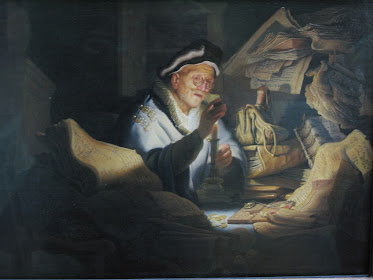From Prodigals to Compassionate Samaritans
Today's post focuses on chapter 3, "How do Parables Work?" in which I use Rembrandt's The Money Changer (Der Geldwechsler) or The Rich Fool to illustrate how parables and visual art can function in similar ways. This is part two of the posts on chapter 3, and it includes quotes from Thurman and the chapter and some "digging deeper" thoughts that didn;t make it in the final edits of the book itself because of word count.
Quotes about the nature of parables:
“One meaning of mashal can be ‘riddle’— which means that the response of the hearer/reader is essential to the process of creating understanding about the possibly inferred meanings and implications of the mashal.”
“Despite the presence of a moral before or after a fable/mashal/parable, the parable itself does not seek to impose a singular response but instead creates a dialogue and invites or challenges its hearers/readers to participate. Parables, in fact, can be created with and have inherent in their transmission the possibility of having multiple morals, meanings, and applications.”
Quote about the nature of parables and visual art:
“Parables and visual images can omit premises of one kind or another, thus leading to ambiguity and multiple meanings. In many instances, such gaps are intentional.…That aspect of parables can give them tremendous power to affect their hearers and readers in many ways—challenging them to change their attitudes, beliefs, and behaviors. The process provokes divergent responses as interpreters endeavor to understand them, since not every audience member envisions the missing premise in the same way.”
Quote about the nature of parables, Thurman, and the interpretive task: What do parables mean? How do parables work? What do parables want?:
“Thus, a key role for interpreters seeking to make the parables relevant for today is to attempt whenever possible to fill in missing premises or gaps with historical, social, and cultural information, such as Howard Thurman’s Jesus and the Disinherited did. One’s interpretive task does not end there, however. Because Jesus’s parables want something from their hearers or readers, interpreters should then attempt, as Thurman’s book also did, to contextualize the parables of Jesus authentically, making them relevant for contemporary society without anachronizing or domesticating Jesus’s message.”
In the "digging deeper" section I include further information about parable interpretation in its first-century context and the Rembrandt painting, The Money Changer:
In fable collections, morals could be included in a promythium before the fable (cf. Luke 12:15) or in an epimythium after the fable (cf. Luke 12:21). The emphasis is on inculcating ethics. Quintilian argues, for example, that a critical aspect of education was “the formation of a child’s moral character,” which he believed was more important than “any excellence as a speaker.” Fables played a role (e.g., in primary education) to help students learn “what is right and what is wrong” (Strong 2021, 137–38).
Rembrandt’s painting resembles an earlier Gerard van Honthorst painting, An Old Woman Inspecting a Coin (~1623/4), which personifies greed. Rembrandt substitutes an old man for Honthorst’s elderly woman, but the similarities are striking—an elderly person in a dark room, wearing a pince-nez, holding a coin with the right hand, and examining it in the light of a single candle.
Rembrandt uses chiaroscuro—contrasting light and shade—as a dramatic means of portraying a scene and suggesting inner character but with a sense of mystery. Rays of light are reflected in sundry ways and places, just as parables are reflected in different ways in different contexts and heard in numerous ways by various hearers. Rembrandt illuminates some objects clearly, while other aspects remain obscure, placed in the shadows, creating uncertainties and provoking debates. In a similar way, Jesus’s parables illuminate some things as clear as day. Other aspects become clearer as we learn more about the first- century contexts in which Jesus created and his followers preserved, transmitted, and transformed his words. However, still other elements—because of the nature of the parabolic word—remain in shadows, provoking our responses as we endeavor to understand Jesus’s parables more clearly in his context and ours and seek to change our attitudes, beliefs, and behaviors accordingly.






No comments:
Post a Comment